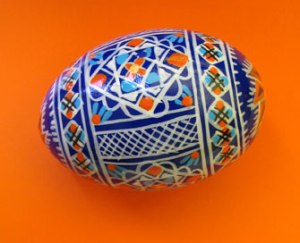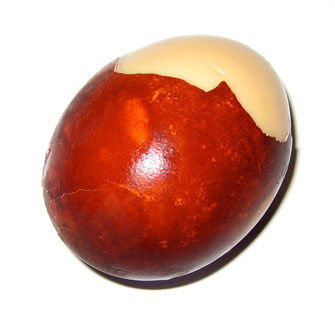According to the Torah, the Paschal (or Passover) lamb (also known as the Korban) was first sacrificed and then offered to God the night that the Israelites began their Exodus out of Egypt. The blood from this lamb was then used to paint a marker on the door posts of the home of each Israelite as a sign to God that he should pass over their home as he went to slay each firstborn Egyptian boy. It is for this reason we eat lamb on Passover, and according to this direct translation in the New Oxford Annotated Bible, even the instructions on how to prepare the lamb (“roasted,” NOT boiled please!) is very clearly commanded by God:
Exodus 12: The Lord said to Moses and Aaron in the land of Egypt, “This month (Nisan) shall be for you the beginning of months; it shall be the first month of the year for you. Tell all the congregation of Israel that on the tenth day of this month they shall take every man a lamb according to their father’s houses, a lamb for a household… and you shall keep it until the fourteenth day of this month (Passover), when the whole assembly of the congregation of Israel shall kill their lambs in the evening. Then they shall take some of the blood, and put it on the two doorposts and the lintel of the houses in which they eat them. They shall eat the flesh that night, roasted; with unleavened bread and bitter herbs they shall eat it. Do not eat any of it raw or boiled with water, but roasted… It is the Lord’s Passover. For I will pass through the land of Egypt that night, and I will smite all the first-born in the land of Egypt, both man and beast; and on all the gods of Egypt I will execute judgements: I am the Lord. The blood shall be a sign for you, upon the houses where you are; and when I see the blood, I will pass over you, and no plague shall fall upon you to destroy you, when I smite the land of Egypt.”
According to one source (History.com) many of those Jews who later converted to Christianity continued this Passover ritual of roasted lamb for Easter (the day of the resurrection of Jesus Christ), referring to it as the “Lamb of God”. Easter takes place around the same time as Passover does each year, and some scholars believe that the Last Supper, which supposedly took place the night before Jesus’s crucifixion, was in fact a Passover dinner.
 As a symbol for life, rebirth, renewal, spring, and eternity since ancient times, the art of egg decoration predates Christianity. According to some sources (see History.com), Mesopotamian Christians began dying eggs red for Easter to recall the blood of Christ, a tradition which carried on to Eastern Europe and evolved into painting the eggs in decorative colors and patterns. Eggs also play an important role on the Seder plate for Passover. This roasted egg is known as the Korban Chagigah (“festival sacrifice;” see photo at top of post) to symbolize the mourning over the destruction of the Temple in Jerusalem (by the Romans in 70 C.E./A.D.), and our inability to make a proper lamb/meat sacrifice to God since then. The egg (representing life) is dipped into salt water symbolizing our tears of mourning, as well as those of our ancestors.
As a symbol for life, rebirth, renewal, spring, and eternity since ancient times, the art of egg decoration predates Christianity. According to some sources (see History.com), Mesopotamian Christians began dying eggs red for Easter to recall the blood of Christ, a tradition which carried on to Eastern Europe and evolved into painting the eggs in decorative colors and patterns. Eggs also play an important role on the Seder plate for Passover. This roasted egg is known as the Korban Chagigah (“festival sacrifice;” see photo at top of post) to symbolize the mourning over the destruction of the Temple in Jerusalem (by the Romans in 70 C.E./A.D.), and our inability to make a proper lamb/meat sacrifice to God since then. The egg (representing life) is dipped into salt water symbolizing our tears of mourning, as well as those of our ancestors.
For those of you celebrating Easter or Passover:
Do you serve lamb for the holiday? If so, how do you prepare it?
Do you have any special traditions that use eggs (such as hiding them or decorating them)?
What do you know about the meaning of eggs and lamb during this holiday?


I’ve just returned from Israel where my sister-in-law roasted a large leg of lamb for Seder. Talk about local and symbolic! Thanks for the info and history. Very interesting, indeed.
Hi Jennifer, this is really an interesting connection between Passover and Easter. What’s a roasted egg though?! Do you roast it in the oven?
We had a very traditional Easter yesterday. Including dying (hard-boiled) eggs in the morning (we also decorated blown-out eggs a few days ago, and hung them in a bunch of pussy willows – so lots of pancakes and other eggy stuff to eat these days), hunting chocolate eggs and marshmallow bunnies in the living room (for the children), and my first roast leg of lamb. I did a mixture of recipes but followed cooking instructions of an ultra-slow roasting recipe (over nine hours at 177 Fahrenheit). The meat came out great, it was very very soft and tender. But I had to realize that most veggies won’t cook well at that temperature… So for such a recipe, the sides can’t just roast together with the meat.
Hi Tina, Some Jews like to roast a single egg for the ceremonial Seder plate on Passover by first hard boiling it (a raw egg would explode), then (using tongs) carefully charring it over an open flame on a gas top stove. Many Sephardic Jews make a version where they cook several whole eggs in their shells in a large pot filled with onion skins, coffee grinds, and a little bit of water for several hours over a a low heat until they turn a deep red-brown color. This process can be done on the stove or in the the oven.